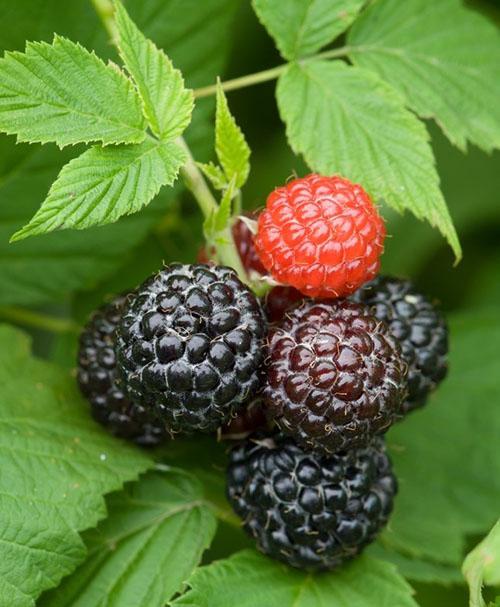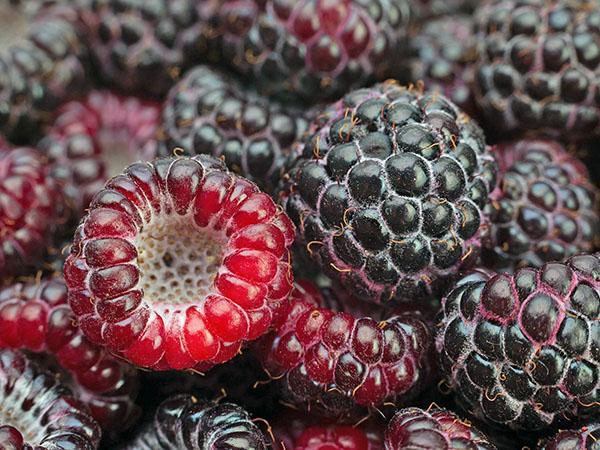Raspberry Cumberland will take its rightful place at the summer cottage
 Raspberry Cumberland attracts attention with its unusual purple-black berries, which are very reminiscent of blackberries, but at the same time have a bright raspberry aroma and are easily separated from the stalk.
Raspberry Cumberland attracts attention with its unusual purple-black berries, which are very reminiscent of blackberries, but at the same time have a bright raspberry aroma and are easily separated from the stalk.
Description of Cumberland raspberries

A century of cultivation experience has proven:
- unpretentiousness of plants and their endurance in a variety of climatic conditions;
- high productivity;
- excellent quality berries.
The Cumberland black raspberry variety is suitable for cultivation from climatic zones 4 to 9. In the north, the shrub perfectly tolerates frosty winters down to -30 degrees, due to late flowering does not suffer from spring frosts. In the south, raspberries can withstand a long and hot summer, do not crumble or "burn" on the branches.
Plants form powerful, arch-shaped shoots from 1.8 to 2.5 meters high. The width of an adult plant can reach two meters.
Unlike modern varieties, which are partially or completely devoid of thorns, Cumberland bushes are truly thorny. This is a serious, but perhaps the only drawback of the old variety.
The Cumberland black raspberry is a medium-ripening variety.
Juicy drupes, collected in simple brushes of 2–7 berries, ripen gradually, while ripe raspberries do not crumble, do not lose their density and shape even for several days after picking. From one shrub, you can collect up to 6-9 kg of excellent quality berries.
 Compared to the more familiar red raspberry, the seeds in black berries seem a little larger, but this does not detract from the taste of the crop.
Compared to the more familiar red raspberry, the seeds in black berries seem a little larger, but this does not detract from the taste of the crop.
Blue-black berries weighing from 1.5 to 5 grams have a sweet, low acidity taste. Raspberries:
- good fresh;
- suitable for home preservation;
- freezing;
- drying.
According to the description of the variety, the Cumberland raspberry is a self-pollinating crop that does not need additional pollinating plants.
The advantages of the variety include resistance to diseases and pests. With proper care and regular pruning raspberries bear fruit up to 14 years, while not forming numerous root shoots, making it easy to control the boundaries of planting.
Planting the Cumberland
 Raspberries are planted in early spring. A well-lit, wind-protected area is prepared in advance. For Cumberland raspberries, loose light soil is ideal, which is ennobled with compost or matured manure at the rate of 8-10 kg per square meter and complex mineral fertilizers for fruiting shrubs.
Raspberries are planted in early spring. A well-lit, wind-protected area is prepared in advance. For Cumberland raspberries, loose light soil is ideal, which is ennobled with compost or matured manure at the rate of 8-10 kg per square meter and complex mineral fertilizers for fruiting shrubs.
Pits or trenches for planting are made according to the size of the plant root system. A gap of about 0.7-1 meters is left between individual bushes. Rows for trellis cultivation are made at a distance of 1.5–2 meters from each other.
If it is supposed to tie overgrown shoots to trellises, they are installed in advance, at the stage of laying planting trenches.
 Before planting, raspberry roots are immersed in water for a couple of hours to restore their proper appearance and freshness. Prepared seedlings are placed in pits, covered with soil, compacted and watered abundantly.After that, it is useful to cover the area around the raspberry bushes with a layer of peat, compost or straw. This will keep moisture in the soil and help the plants take root quickly.
Before planting, raspberry roots are immersed in water for a couple of hours to restore their proper appearance and freshness. Prepared seedlings are placed in pits, covered with soil, compacted and watered abundantly.After that, it is useful to cover the area around the raspberry bushes with a layer of peat, compost or straw. This will keep moisture in the soil and help the plants take root quickly.
Cumberland Raspberry Care
 The future of the raspberry crop depends on the care of the plants planted on the site.
The future of the raspberry crop depends on the care of the plants planted on the site.
Post-planting care for the Cumberland Jemalina includes:
- watering;
- weed removal;
- pruning;
- feeding.
As soon as a young growth appears, it is fixed on a trellis, in parallel, weak, frozen or damaged parts of the plant are cut out at ground level. As a result, a healthy bush should consist of 6-8 strong shoots. To stimulate the formation of side shoots, raspberries that have grown to a meter in height are pinched. Semi-lignified apical shoots are used for rooting and propagation of Cumberland black raspberries.
It must be remembered that the growth of black raspberries in breadth must be controlled and cut, otherwise the plantings that have turned into a thorny fence will not allow to harvest the ripe crop.
The berries are watered abundantly, preventing stagnation of moisture in the soil. Young plants need watering every other day, perennial plants - once a week. Regular mulching helps to preserve moisture in the hot season and on light sandy soil. It is convenient to combine watering with dressing.
Fertilization is carried out three times:
- in spring, fruiting plantings are fertilized with organic matter in combination with a complete mineral complex for berry crops;
- in the summer, when raspberries bear fruit, they are supported with a potassium-phosphorus agent;
- the third top dressing is necessary after harvest.
 Raspberry Cumberland is hardy enough. The main danger for her is powdery mildew. Harmful fungi can deprive the plant of vitality, weaken the plant and deprive the gardener of the harvest. The disease looks like flour scattered over the leaves. First, separate spots appear on the greenery. If the lesions are not treated, the leaves will begin to turn yellow and dry out. The spread of fungi threatens the death of green shoots.
Raspberry Cumberland is hardy enough. The main danger for her is powdery mildew. Harmful fungi can deprive the plant of vitality, weaken the plant and deprive the gardener of the harvest. The disease looks like flour scattered over the leaves. First, separate spots appear on the greenery. If the lesions are not treated, the leaves will begin to turn yellow and dry out. The spread of fungi threatens the death of green shoots.
To treat a shrub for powdery mildew, it is important to remove the affected leaves, buds and fruits, and then treat the black raspberry with a fungicide.
In the fall, when the growing season ends, black raspberries are pruned. Old, fruiting shoots in summer are removed by cutting at soil level. The annual branches are pinched, leaving 5-6 buds.
Cumberland is a winter-hardy variety that tolerates Russian winters well. If frosts below 30 degrees are not uncommon in the region, it is better to bend the shoots to the ground and sprinkle them with spruce branches.